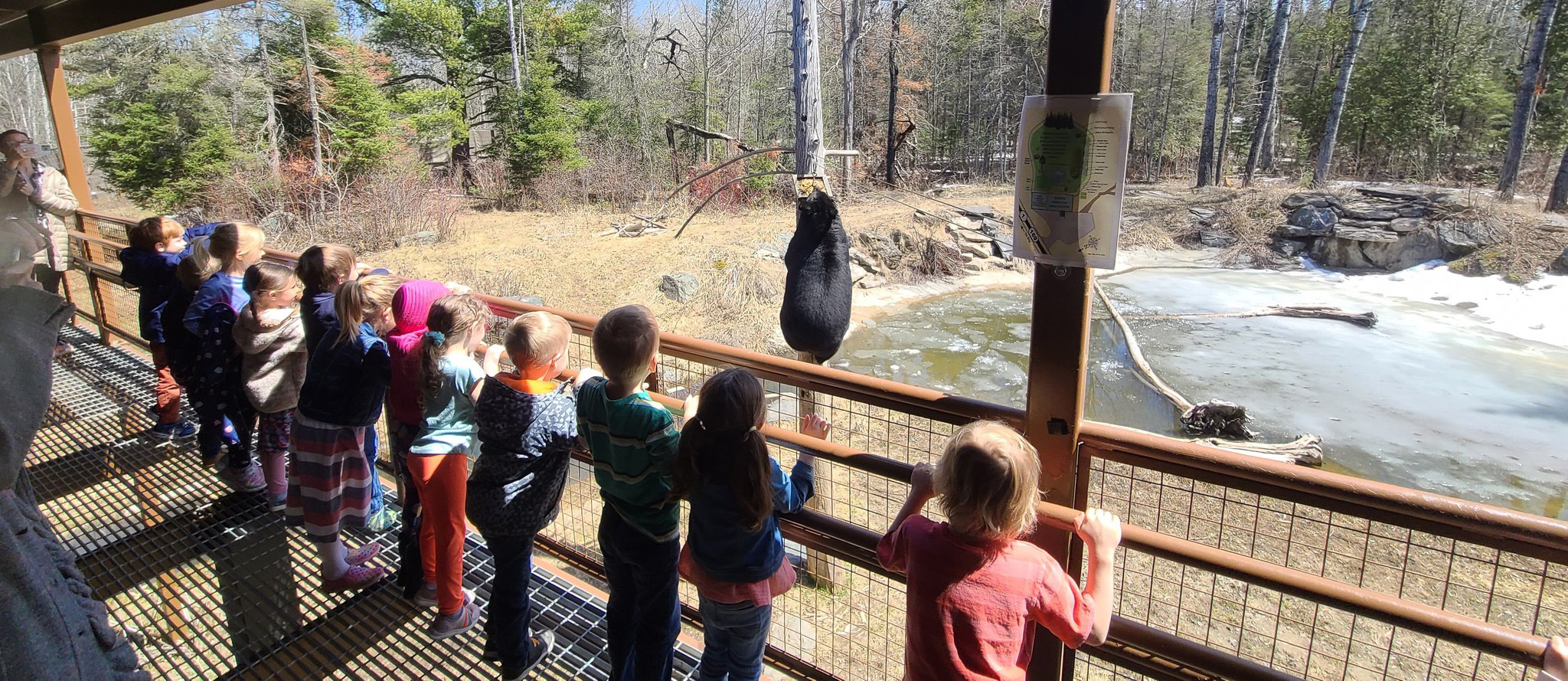
Bear News – SEPTEMBER 2025
Bear News for September
We will not post weights this month due to the weights and dates contest. Good luck to all.
Anyone who has been to the Bear Center knows that education about Ursus americanus the American Black bear is a primary goal. Along with that comes dispelling myths about the black bear and replacing the myth with facts. This is a result of Dr. Lynn Rogers, a world renowned bear biologist and his 50 plus years of research.
Dr. Rogers created the North American Bear Center to educate the public about a creature that is timid and shy and not fierce and ferocious. https://bear.org/visit-us/
In doing so, he knew he would have to have live bears. He provided a 2.5 acre habitat, which in 2007, included a set of bunker dens for the late and great Ted Bear and Honey Bear.
A new enclosure was made later that year for Lucky Bear, a rambunctious cub. Our Lucky bear is now 18 years old and has moved into his geriatric years. Along with Holly and Tasha, they were introduced to their present enclosures in 2023.
Dr. Rogers also knew that just reading words can be boring, so he added videos of bears doing many different behaviors. He provided a sound board for the various vocalizations bears make. Of all the vocalizations, there isn’t one of a black bear growling because they do not have the vocal cords to make the growling sound.
Movies portray black bears as vicious predators and dub in the sounds of a lion or wolf.
Since the Ice Age, the black bear has been a preyed upon animal and not a true predator.
In his wisdom as the founder of the NABC, Dr. Rogers also knew that the bear itself is a primary teacher. Its behavior, vocalizations, personalities, habits, feeding preferences and mating rituals can only be learned from the bear itself.
At the Bear Center the bears do most of the teaching. Our Behind the Scenes programs are designed to allow our visitors to see bears and learn their behaviors. Staff, based on biological degrees and knowledge with information gleaned from Dr. Rogers provides informative programs for the guests.
Some of the things people have seen our bears and where you can find the facts. https://bear.org/bear-facts/
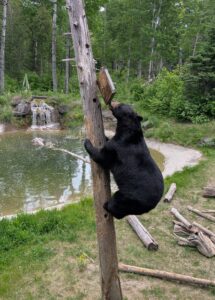 Climb- Even our 450 pound Lucky still climbs. Their claws are designed for climbing and tearing into logs for insects and larvae.
Climb- Even our 450 pound Lucky still climbs. Their claws are designed for climbing and tearing into logs for insects and larvae.
Bluster- meaning a vocalization- you’re in my space! https://bear.org/bear-facts/
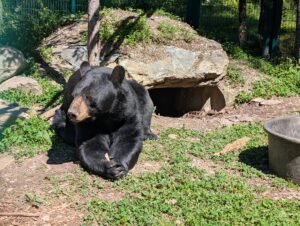 Feed-they eat their foods using their sticky tongues to pick food up individually. The diastema is a small gap behind the canines where the small useless premolars grow. This area is used for cracking nuts or stripping branches. Did you know that a black bear’s diet is less than 10% protein and mostly 90% vegetation. https://bear.org/bear-facts/
Feed-they eat their foods using their sticky tongues to pick food up individually. The diastema is a small gap behind the canines where the small useless premolars grow. This area is used for cracking nuts or stripping branches. Did you know that a black bear’s diet is less than 10% protein and mostly 90% vegetation. https://bear.org/bear-facts/
Play- all of our bears chase each other, do somersaults, and spar with each other. Cubs play in the den and learn their roles as they grow. Play continues outside the den and teaches the cubs how to defend themselves. https://bear.org/bear-facts/
Mental Stimulation through enrichment- Our bears get enrichment daily to keep them mentally alert and always looking to solve a food reward. Did you know bears in the wild can problem solve how to get your bird feeder down.
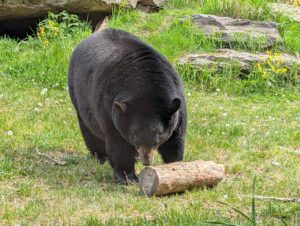 Foraging- Our bears are given a complete spread of food in the main enclosure daily. Did you know a bear is usually active before sunrise, and is active into the evening but bed down a couple hours after dark. https://bear.org/our-bears/
Foraging- Our bears are given a complete spread of food in the main enclosure daily. Did you know a bear is usually active before sunrise, and is active into the evening but bed down a couple hours after dark. https://bear.org/our-bears/
Rest- The bears are provided with a 2 acre parcel of forest and rocks for rest and digging. Their individual dens are provided for hibernation, protection from storms and rest. Bears nap throughout the day especially if their belly is full.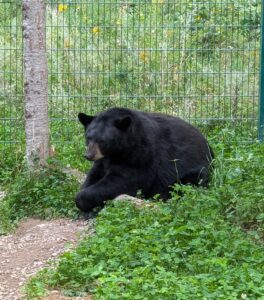
Bi-pedal walk or stand- Bears stand up to get a better look at what might be dangerous, they are not standing up to show their teeth. They have an organ located on the inside top of their mouth called a vomeronasal organ (olfactory system) which allows a bear to smell seven times better than a bloodhound dog and a nasal mucosa area one hundred times greater than a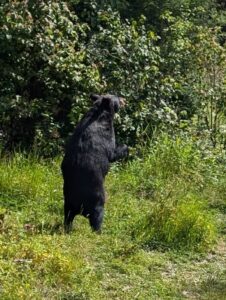 human. https://bear.org/bear-facts/
human. https://bear.org/bear-facts/
Swimming- The Bear Center has a pond and overflow area for our bears to swim in. Bears swim to cool off and to get from shore to shore. Cubs that tire ride on mom’s back. Swimming Ability: Good. Speed and distance limits are untested. Can swim at least a mile and a half in fresh water. One swam more than 9 miles in the Gulf of Mexico. Can swim to island campsites.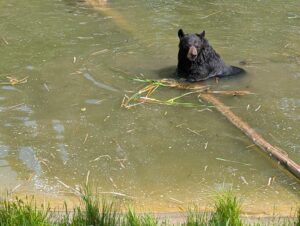
Hibernation- all of our bears hibernate. Holly enjoys digging her own den while Tasha and Lucky use any of the 7 dens we provide them with. Although we can’t see in the dens, we provide cameras to watch all winter. https://bear.org/bear-facts/
I hope this gives those of you a sample of what our bears are capable of and insight into the black bear world.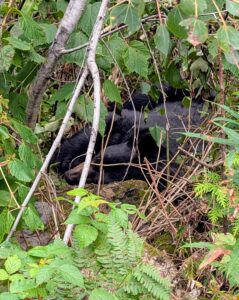
I may sound like a recording but our need for pecans, cranberries, dried cherries continues through the fall so I will keep asking. If you find it in your budget to provide something for the bears you can find our wishlist on https://bear.org/support-us/
Thank-you for all you do,
Sharon Herrell, Bear Keeper
North American Bear Center
We are a 501(c)(3) non-profit that relies entirely on the support of visitors, merchandise sales and people like you. We do not receive any state or federal funding.
Help support our mission.
Donate Now